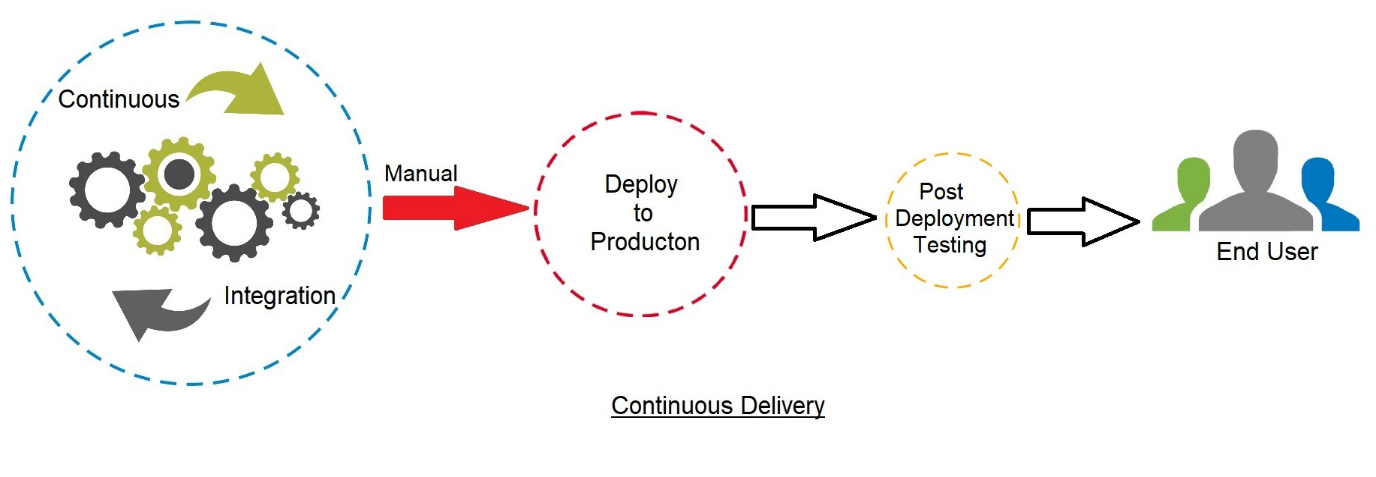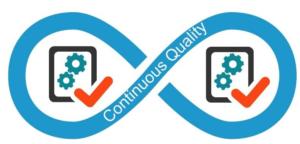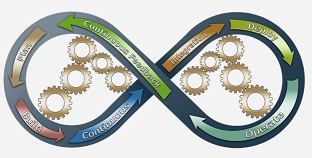Accelerate Success with AI-Powered Test Automation – Smarter, Faster, Flawless
Start free trialCI/CD are fundamental bases of DevOps. CI stands for Continuous Integration, while CD can either mean Continuous Deployment or Continuous Delivery. In this particular article, we will take a deep dive into the concepts of Continuous Deployment.
Continuous Integration is the practice of merging all developers’ working copies to a shared repository several times a day.
Continuous Deployment is a critical phase of the CI/CD process of DevOps. Rapidly changing requirements, demands for introduction of new features and improvements in software makes it imperative to have a fast and seamless process in place for quick development, testing, deployment and final release.
Continuous Deployment achieves this by fully automating software delivery pipelines. It enables organizations to respond to market demands for high quality solutions in a lesser amount of time. It is a strategy that achieves intermittent release milestones without affecting the current software functionality.
Continuous Delivery and Continuous Deployment are two terms that are often used interchangeably when it comes to software releases. However, both are different from each other when it comes to implementation.
How Continuous Deployment is Different From Continuous Delivery?
Continuous Delivery and Continuous Deployment hold the key for releases as per the business demands.
Continuous delivery is the practice that ensures that the tested and verified modules are always in a ready state for release. These changes can be released to production on demand. Continuous Delivery process includes one manual step which initiates the deployment to production. This practice gives the development team the flexibility to make smaller, incremental changes on a continuous basis, but are not released to end users until the product owner/manager desires a release of some cohesive accumulated capability.

While in Continuous Deployment, any new changes that are committed to the master code are automatically deployed to production environment, if they pass the testing phase.

This article discusses how Continuous Deployment helps in converting a software concept to a high quality end product for the customer and benefits entailing it.

Key Elements in Continuous Deployment Process
Continuous deployment is a strategy for software releases in which any code commit that successfully passes the automated testing phase is automatically released into the production environment.
It is imperative to have a strong culture of Continuous integration in place for a successful Continuous Deployment. The foundation of the whole process needs to be solid in order to reap benefits.
Continuous deployment process can be broadly broken down into 4 key elements as shown in the following process diagram.

- Deploy to Production
The deployment process is triggered by successful Continuous Integration and validation process.
Deployment process has to be quick and reliable. To achieve this, all related modules, submodules, third party tools, configuration files etc. need to have the latest updated versions maintained in a version control system and the deployment steps have to be executed via automation tools.
There should be consistency between development, staging and production environments. Consistent environments and processes reduces the risk failure significantly.
- Testing and Verification
Testing and verification is extremely critical element in continuous deployment before the software is released to end users. The rate at which the changes are deployed to production calls for rigorous testing process. Testing process should be fast, dynamic and automated. Typically the test suite should contain a variety of regression tests, acceptance tests, performance tests, security tests and smoke tests.
- Monitoring
Automated systems monitor and measure the effectiveness of deployment process. This ensures that every commit that is rolled out to production is monitored and relevant stakeholders are alerted in case of any errors. It is a good idea to have a robust real time monitoring system in place to reduce the recovery time in case of any errors discovered during deployment. A well-defined monitoring system ensures smooth flow of CI/CD pipelines.
- Respond and Recover
Even after thorough testing unexpected issues may crop up in production environment. In such scenarios, there should be a system in place which addresses these issues by identifying the root cause and fixing them. The system should be able to rollback to previously working state.
Importance of Continuous Quality in Continuous Deployment Process

DevOps process ensures that there is a well-defined testing process in place at Integration level and at deployment level. Testing process should be continuous, automated and aligned with the speed of development.
But, continuous testing does not necessarily translate to continuous quality. High quality end product is the result of attention to continuous quality throughout the development process.
Continuous quality can be achieved by defining an end to end test automation strategy. This strategy ideally spans the entire CI/CD pipeline.
Automated testing framework aids in swift and early detection of bugs, which in turn helps the teams in making informed decisions and choices regarding the fixes. Without automated testing, the speed of feature deployment is limited by the speed of testing and quality assurance.
While it is important to test throughout the pipeline, at the same time, it is also vital to choose the right tests at the right time to maximize the benefits. Strategic inclusions of smoke tests and regression tests in the test plans prove beneficial in the quality assurance process.
Rules of Thumb for CD

Certain rules of thumb have to be considered for Continuous Deployment to work effectively:
- A well-functioning Continuous Integration process must be in place before Continuous Deployment can be implemented.
- Development, quality assurance and operations teams must have shared goals.
- Continuous quality & regression process is defined.
- Good communication flow and collaboration should be there between the teams.
- It is vital to have knowledge sharing, sharing of procedures and tools between the teams.
- There should be an automated process for post deployment tests.
- Well defined Real Time Monitoring system should be in place.
- Deployment and rollback procedures should be simple, repeatable and reliable.
- In addition to rollback, many companies that practice CD only roll forward. Generally a feature is introduced with configuration flag to enable/disable it. If it does not work on deploy, it can be disabled, and then fixed/released in the next release or when it is ready.
- There should be a provision to stop the whole pipeline in case anything breaks the flow/process.
- Continuous Deployment process should be repeatable, reliable and incrementally improving.
Benefits of Using Continuous Deployment Process

- Time Saving
- Improved Speed of Development: Since Development does not pause for deployment and release, the coding process is much faster.
- Improved Speed of Bug fixes: As soon as any feature is rolled out, the users start using it and report bugs early. This gives enough bandwidth to developers to rectify it as they don’t have to dig deep into the past to find it.
- Optimal utilization of time: Automatic Deployment aids the team to reprioritize tasks on a continuous basis and focus on other tasks than investing time in manual deployment.
- Continuous Deployment works best when all related deployment tools and process are under version control with latest version always available for use. This consolidation of resources aids in faster troubleshooting.
- Enhanced Visibility and Tracking
- It becomes much easier to measure progress when the large releases are broken down into smaller chunks which are continuously deployed.
- Continuous deployment supports continuous improvements which are visible to customers making it easier for them to keep track of progress.
- Reduced Risk and Cost
- Enhanced visibility and tracking helps in reducing developments risks.
- Releases become smaller and easier to understand. Hence, the identification and resolution of defects also becomes easier.
- The risk involved is much less.
- It facilitates in better cost estimations and tasks can be prioritized accordingly.
- Enhanced Quality of Release
- The principle of deploying even the minuscule changes makes sure that bugs are caught early and rectified immediately, resulting in high quality deliverable.
- Better collaboration between the Development, QA, and Operations teams leads to higher quality deliverable and higher customer satisfaction.
- Increase customer feedback and satisfaction
- The feedback loop with the customers is faster since all the new features and enhancements are deployed to production as and when they are ready.
- Early feedback from customers for the features released to production helps in improvising/customizing the application further.
- Increased Innovation
- Rapid deployment and feedback loop encourages the team to experiment and generate new ideas for improvisations and/or new feature development.
- It facilitates the development of alternate versions of features and developers can compare which approach works better.
Conclusion
Continuous Deployment has allowed the organizations to respond promptly to any market changes, also the response time for dynamically changing customer expectations and demand for services is reduced significantly. Reduced lead time between conceptualization to software realization facilitates in earlier return on investments for large scale projects. Additionally, the quality of product improves exponentially.
Besides having a good development strategy in place, it is prudent to have a well-defined continuous quality process too. Choosing the right test automation tool helps in monitoring project progress, significantly shortens the release cycles and provides continuous feedback, which can then be used to improve the product.
At Webomates we have optimized testing by combining our patented selenium based Automation and Artificial Intelligence with crowdsource and manual testing. We accelerate peace of mind at deployment, at a significantly lower total cost. It is directly integrated with your build system and regression testing can be done with each build integration and deployment.
If you are interested in learning more about Webomates then please click here and schedule a demo, or reach out to us at info@webomates.com
Read Next –
Test Automation vs Manual Testing


Leave a Reply